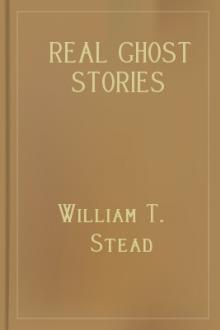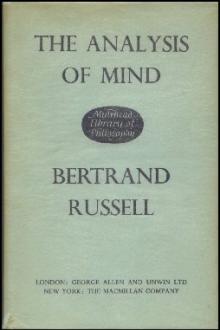Real Ghost Stories, William Thomas Stead [digital book reader .txt] 📗

- Author: William Thomas Stead
- Performer: -
Book online «Real Ghost Stories, William Thomas Stead [digital book reader .txt] 📗». Author William Thomas Stead
"With that, he turned abruptly and went out. Anxious to retain his good-will, I shouted after him, 'Can I post what may be done?' but I got no answer. I turned once more to the book, looked at the number, and on a slip of paper wrote No. 7976, Thompson, post. (This I wrote with pen and ink, and have the paper yet.)."
Mr. Dickinson said he had handed over this piece of paper to a representative of the Psychical Research Society who had lost it. It was, however, a mere memorandum written on the back of a traveller's card.
"At nine o'clock, when Miss Simon (clerk and reception room attendant, a bright, intelligent young lady) came, I handed the slip of paper to her, and asked her to have it attended to, telling her that the man had called for them, and seemed much disappointed that he had not received them before. Miss Simon, with considerable surprise, exclaimed, 'Why, an old man called about these photographs yesterday (Friday), and I told him they could not be ready this week owing to the bad weather, and that we were nearly three weeks behind with our work.' I suggested that it was quite time Mr. Thompson's were ready, and inquired who was printing the order. I was told that it was not in print, and, pointing to a pile of negatives, Miss Simon said 'Thompson's is amongst that lot, and they have been waiting quite a fortnight.' I asked to be shown the negative, and about half an hour later Miss S. called me saying 'This is Thompson's negative.'
"I took it in my hands and looked at it carefully, remarking, 'Yes, that is it; that is the chap who called this morning.'"
Mr. Dickinson said he had no difficulty in recognising it, although the man wore a hat and top-coat when he called, whereas in the portrait the sitter wore neither hat nor top-coat.
"Miss Simon again referred to the fact that she had told the man who had called on the previous day that none were done, or could be done that week. 'Well,' I said, 'put this to one side, and I will see to it myself on Monday, and endeavour to hurry it forward.' On the Monday (January 5th) I was in one of the printing-rooms, and about 10.30 a.m., having one or two printing-frames empty, I thought of Thompson's negative, and accordingly went down to the office and asked Miss S. for it. 'Oh! yes,' she replied, 'and here are a few more equally urgent, you may take them as well.' I said, 'That cannot be, as I have only two or three frames at liberty' (she had about twenty negatives in her hand, holding them out to me); 'give me Thompson's first, and let me get my mind at rest about it.' To which she answered, 'His is amongst this lot, I will have to pick it out.' (Each negative was in a paper bag.)
"I offered to help her, and she commenced at one end of the batch and I at the other; and before we got halfway through I came across one which I knew was very urgent, and turned away to look up the date of taking it, when crash! went part of the negatives on the floor. This accident seemed so serious that I was almost afraid to pick up the fallen negatives, but on doing so, one by one, I was greatly relieved to find only one was broken; but, judge of my horror to find that that one was Thompson's!
"I muttered something (not loud, but deep), and would fain have relieved my feelings, but the presence of ladies restrained me (this accident being witnessed also by my head printer, Miss L.).
"I could not honestly blame Miss Simon for this—each thought the other was holding the lot, and between us we let them drop.
"The negative was broken in two, right across the forehead of figure. I put the pieces carefully away, and taking out a memo. form, wrote to Mr. Thompson, asking him to kindly give another sitting, and offering to recoup him for his trouble and loss of time. This letter was posted five minutes after the negative was broken, and the affair was forgotten by me for the time.
"However, on Friday, January 9th, I was in the printing-room upstairs, when I was signalled by the whistle which communicates with the office, and Miss Simon asked if I could go down, as the gentleman had called about the negative. I asked 'What negative?' 'Well,' she replied, 'the one we broke.'
"'Mr. Thompson's,' I answered. 'I am very busy and cannot come down, but you know the terms I offered him; send him up to be taken at once.'
"'But he is dead!' said Miss Simon.
"'Dead!' I exclaimed, and without another word I hastened down the stairs to my office. Here I saw an elderly gentleman, who seemed in great trouble.
"'Surely,' said I to him, 'you don't mean to say that this man is dead?'
"'It is only too true,' he replied.
"'Well, it must have been dreadfully sudden,' I said, sympathetically, 'because I saw him only last Saturday.'
"The old gentleman shook his head sadly, and said, 'You are mistaken, for he died last Saturday.'
"'Nay,' I returned, 'I am not mistaken, for I recognised him by the negative.'
"However, the father (for such was his relationship to my sitter) persisted in saying I was mistaken, and that it was he who called on the Friday and not his son, and, he said, 'I saw that young lady (pointing to Miss Simon), and she told me the photographs would not be ready that week.'
"'That is quite right,' said Miss Simon, 'but Mr. Dickinson also saw a gentleman on the Saturday morning, and, when I showed Mr. Dickinson the negative, he said, "Yes, that's the man who called." I told Mr. Dickinson then of your having called on the Friday.'
"Still Mr. Thompson, sen., seemed to think that we were wrong, and many questions and cross-questions I put to him only served to confirm him in his opinion that I had got mixed; but this he said—no one was authorised to call, nor had they any friend or relative who would know of the portraits being ordered, neither was there any one likely to impersonate the man who had sat for his portrait.
"I had no further interview with the old gentleman until a week later, when he was much calmer in his appearance and conversation, and at this interview he told me that his son died on Saturday, January 3rd, at about 2.30 p.m.; he also stated that at the time I saw him (the sitter) he was unconscious, and remained so up to the time of his death. I have not had any explanation of this mysterious visit up to present date, February 26th, 1891.
"It is curious to me that I have no recollection of hearing the man come upstairs, or of him going down. In appearance he was pale and careworn, and looked as though he had been very ill. This thought occurred to me when he said he had been travelling all night.
"James Dickinson.
"43, Grainger Street, Newcastle."
Miss Simon, in further conversation with me, stated that when the father called on Friday night and asked for the photographs, he came late, at least after the electric light was lit. He seemed disappointed, but made no further remark when he was told they were not ready. Mr. Dickinson stated that in conversation with the father afterwards, he told him that his son, on the Friday, had been delirious and had cried out for his photographs so frequently that they had tried to get them, and that was why he had called on Friday night. Hebburn is on the south side of the Tyne, about four miles from Newcastle. The father was absolutely certain that it was physically impossible for his son to have left the house. He did not leave it. They knew the end was approaching, and he and his wife were in constant attendance at the death-bed. He also stated that it was impossible, from the position of the bedroom, for him to have left the house, even if he had been able to get out of bed without their hearing him. As a matter of fact, he did not get out of bed, and at the moment when his Double was talking to Mr. Dickinson in Grainger Street he was lying unconscious at Hebburn.
It is impossible to explain this on the theory that Mr. Dickinson visualised the impression left upon his mind by Mr. Thompson, for Mr. Dickinson had never seen Mr. Thompson in his life. Neither could he have given apparent objectivity to a photograph which he might possibly have seen, although Mr. Dickinson asserts that he had never seen the photograph until it was brought him on the Saturday morning. If he had done so by any chance he would not have fitted his man with a top-coat and hat. It cannot, therefore, be regarded as a subjective hallucination; besides, the evidence afforded by the looking up of the book, the making an entry of what occurred, and the conversation which took place, in which the visitor mentioned facts which were not present in Mr. Dickinson's own mind, but which he verified there and then by looking up his books, bring it as near certainty as it is possible to arrive in a case such as this. Whoever the visitor was, it was not a subjective hallucination on the part of Mr. Dickinson.
It is equally impossible to believe that it was the actual Mr. Thompson, because he was at that moment within six hours of death, and the evidence of his father is that his son at that moment was physically incapable of getting out of bed, and that he was actually lying unconscious before their eyes at Hebburn at the moment when his apparition was talking to Mr. Dickinson at Newcastle. The only other hypothesis that can be brought forward is that some one personated Thompson. Against this we have the fact that Mr. Dickinson, who had never seen Thompson, recognised him immediately as soon as he saw the negative of his portrait.
Further, if any one had come from Hebburn on behalf of Thompson, he would not have asserted that he was Thompson himself, knowing, as he would, that he was speaking to a photographer, who, if the photographs had been ready, would at once have compared the photographs with the person standing before him, when the attempted personation would at once have been detected. Besides, no one was likely to have been so anxious about the photographs as to come up to Newcastle an hour before the studio opened in order to get them.
We may turn it which way we please, there is no hypothesis which will fit the facts except the assumption that there is such a thing as a Thought Body, capable of locomotion and speech, which can transfer itself wherever it pleases, clothing itself with whatever clothes it desires to wear, which are phantasmal like itself. Short of that hypothesis, I do not see any explanation possible; and yet, if we admit that hypothesis, what an immense vista of possibilities is opened up to our view!
"There is something in that ancient superstition
Which erring as it is, our fancy loves."—Scott.
Chapter I.
My Irish Friend.
Many of the apparitions that are reported are





Comments (0)